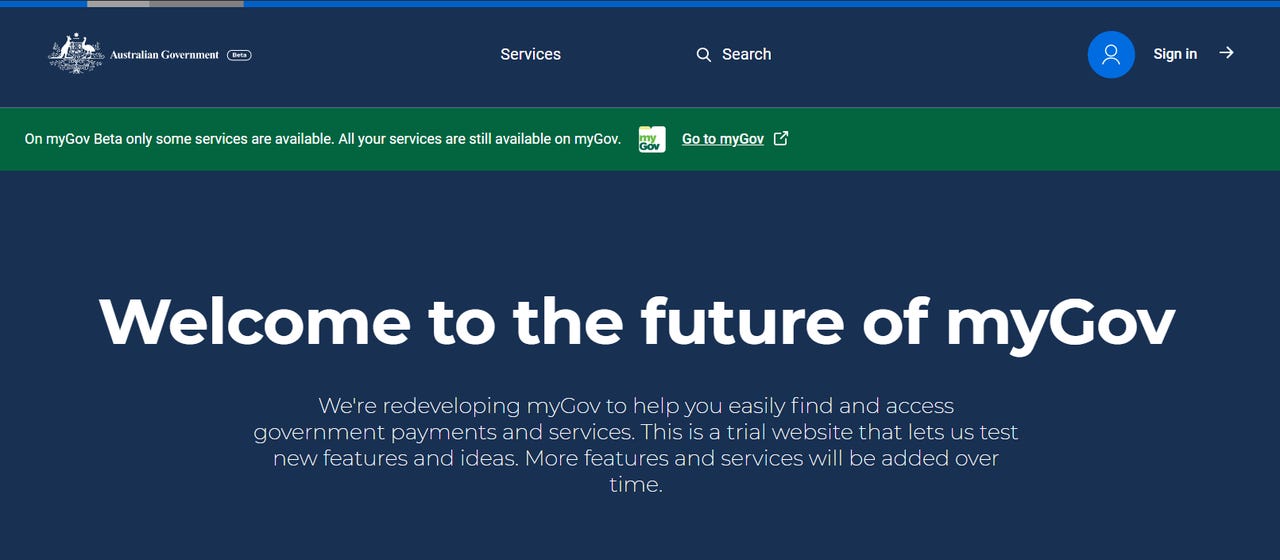Six unplanned myGov outages in 20-21 with the longest one lasting 90 minutes


myGov beta website
Services Australia has taken the opportunity to say myGov outages were slashed by almost half in 2020-21, when compared to the year prior.
In response to questions taken on notice during Senate Estimates in May, Services Australia said during 2020-21, there were four planned and six unplanned outages to the myGov platform.
"Planned outages typically last a maximum of three hours, and the average resolution time for the five unplanned outages was 41 minutes," it said.
Offering further information, Services Australia general manager Hank Jongen told ZDNet the agency has "significantly bolstered" myGov over the last two years so it now has the largest capacity of any authenticated online platform in Australia.
"We continue to make improvements to increase the capabilities of our platforms, including myGov, which helps us address service issues as quickly as possible," he said.
Jongen said the six unplanned outages were due to "underpinning hardware and software issues" and that the number reduced from 11 in the previous financial year.
The duration of the six outages were 13 minutes, 14 minutes, 18 minutes, 34 minutes, 64 minutes, and 96 minutes.
"Once services were restored, there were no further service impacts for customers," he added.
In March last year, myGov crashed when many Australians tried to determine if they qualified for COVID-19 support from the country's Centrelink scheme.
Former Minister for Government Services Stuart Robert was quick to claim the portal suffered a distributed denial of service (DDoS) attack, however it was simply 95,000 people trying to connect to myGov that had triggered a DDoS alert, and not an attack at all.
"We've gone from 6,000 to 50,000 to 150,000 all in the space of, a matter of a day. And tonight, they're working to boost it again. I would say to Australians, yes, we are terribly sorry, but at the same time, we are asking Australians, even in these most difficult of circumstances, to be patient. Everyone is doing their best," Prime Minister Scott Morrison later clarified.
See also: Two Cashless Debit Card outages and nearly 21,000 Australians on welfare quarantine
Services Australia also revealed on notice the amount it spent in the past three financial years on IT after being asked by senators during a public sector capability hearing how the agency's spending is allocated against legacy programs and new capability.
"In some ways, we are somewhat different to many of the other federal government agencies because of … not only shared services, it is also the piece around ongoing software development work," Services Australia chief transformation officer Charles McHardie said during the hearing last month.
"We are writing new code all of the time, some of it in legacy systems. But if you look at our cost breakdown for fiscal year 2020-21 -- this is just for the core technology services group -- out of an overall budget of AU$1.395 billion, just on a billion of that is on operating expenditure, with AU$369 million in capital.
"A lot of it is keeping the lights on. When I say 'keeping the lights on', that is not only keeping the lights on as far as hardcore infrastructure is concerned -- physical servers, data centres, networks -- but it's also looking after the corporate applications that our staff use day in, day out. It's also looking after all of those large transactional processing systems."
In 2018-19, total IT expenditure, minus spend on legislative projects, came in at AU$1.35 billion. In 2019-20 and 2020-21, where legislative spend was not redacted, total spend was AU$1.52 billion and AU$1.48 billion, respectively.
Breaking down 2018-19, just shy of AU$1.06 billion in operating expenditure was comprised of AU$262.5 million on major programs and AU$796.6 million listed as sustainment operating. Total capital was AU$292 million, made up of AU$189.4 million on major programs and sustainment capital spend came in at AU$102.7 million.
In 2019-20, total operating expenditure was AU$1.05 billion, with AU$134.4 million on major programs, AU$871 million under sustainment, and AU$47 million on legislative projects. Capital was AU$155.7 million on major programs, nearly AU$302 million on sustainment, and almost AU$17 million on legislative projects, totalling just under AU$474 million.
Total operating expenditure in 2020-21 was AU$1.07 billion, this comprised AU$124 million on major programs, nearly AU$850 million on sustainment, and AU$99 million on legislative projects. Total capital spend for the year was almost AU$414 million, with AU$206.4 million spent on major programs, AU$151.4 million on sustainment, and AU$56 million on legislative projects.
Income from shared services IT was AU$121 million in 2019-20 and AU$127.3 million in 2020-21.
RELATED COVERAGE
Services Australia battling large-scale transformation and an APS IT talent shortfall
The super agency has eight large transformation programs underway that the rest of the Commonwealth hopes to re-use, but the Community and Public Sector Union would argue Services Australia staff are being left behind amid the bureaucracy.
Gordon Legal on robo-debt class action: It was never meant to be a Royal Commission
In addition to highlighting its work was not in lieu of a Royal Commission, the law firm that brought on a class action against the Commonwealth believes the minister's claims of public interest immunity are no longer relevant as the legal proceedings are all but officially over. Meanwhile, Labor has asked again for a Royal Commission.
There are 84 high-cost IT projects underway by the Australian government
Home Affairs is responsible for 24, the ATO for 12, Defence for nine, and Services Australia seven. Here they are.